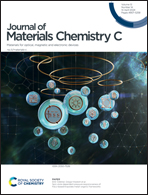Towards opto-structural parameters to enhance the circularly polarized luminescence brightness of EuIII β-diketone complexes with chiral auxiliary ligands†
Abstract
Circularly polarized luminescence (CPL) from lanthanide (LnIII) complexes has aroused extensive attention in the last decade owing to its potential use in displays or as anti-counterfeiting devices, for instance. However, the design of LnIII complexes matching high luminescence dissymmetry factor and CPL brightness still limits their real application. To help deal with this challenging task, presented herein is a series of [Eu(hfa)3(chiral)] complexes, (chiral = S-Bn-pybox = 2,6-bis((S)-4-benzyl-4,5-dihydrooxazole-2-yl)pyridine, S-Ph-pyox = (S)-4-phenyl-2-(pyridin-2-yl)-4,5-dihydrooxazole, or (R)-Cl-(S)-Ph-pzox = N-((R)-2-cloro-1-phenyletyl)-3-((S)-4-phenyl-4,5-dihydrooxazole-2-yl)pyrazine-2-carboxamide; hfa = 1,1,1,5,5,5-hexafluoro-2,4-pentanedione), aiming to understand through opto-structural correlations how the overall emission quantum yield (ϕLLn), dissymmetry factor (glum), as well as CPL brightness can be finely tuned by changing the electronic structure and symmetry of the EuIII coordination polyhedron. [(Eu(hfa)3(S)-Bn-pybox)] displayed the largest |glum| values (0.36 in dichloromethane) for the 5D0 → 7F1 transition and the highest CPL brightness reported so far (465 M−1 cm−1 in dichloromethane) for the 5D0 → 7F2 transition. By combining the experimental photoluminescence and computational data, we were able to show that the bright CPL is a consequence of the quite high emission quantum yield in dichloromethane (41.4%), the large branching ratio of the 5D0 → 7F2 transition, and the increase of the magnetic dipole momentum contribution to the EuIII transitions owing to the low EuIII local microsymmetry. Thus, our investigation helps to provide further guidance on how the electronic structure of the complexes and the EuIII local microsymmetry can play synergistically to improve the CPL brightness of EuIII complexes.



 Please wait while we load your content...
Please wait while we load your content...